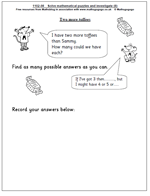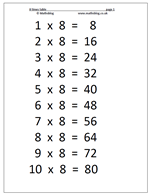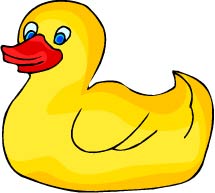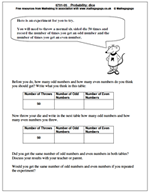Year 1 maths worksheet from mathsblog.co.uk
 Sometimes children develop the idea that there can only be one answer to a problem, especially if they are brought up on a diet of ‘sums’ which are either right or wrong. In reality, there are often many correct answers to mathematical problems and this is where investigations come into their own.
Sometimes children develop the idea that there can only be one answer to a problem, especially if they are brought up on a diet of ‘sums’ which are either right or wrong. In reality, there are often many correct answers to mathematical problems and this is where investigations come into their own.
Here we have a simple problem, which actually has an infinite number of correct answers. When approaching this, even at the age of 5 or 6 we should be looking for some kind of logical thinking and organisation in recording answers.




 Free maths worksheet: Standard written method for addition of two 3-digit numbers.
Free maths worksheet: Standard written method for addition of two 3-digit numbers.